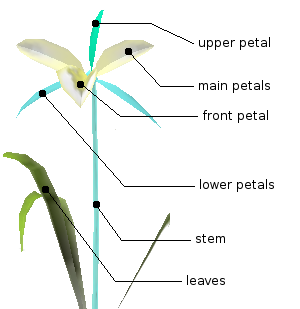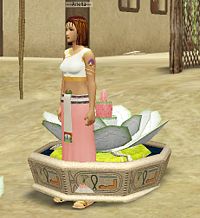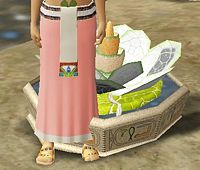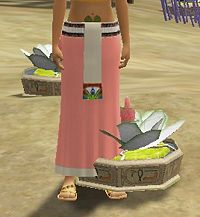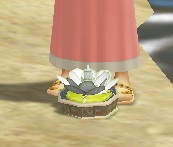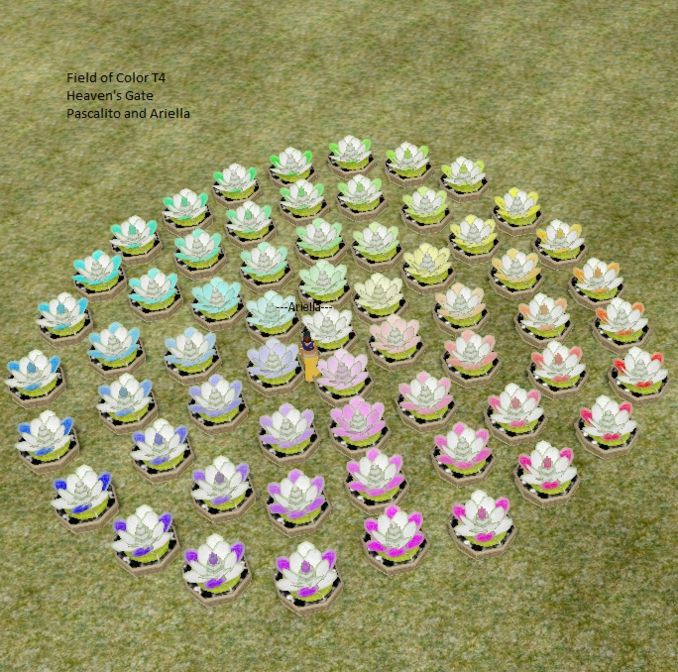The Wiki for Tale 8 is in read-only mode and is available for archival and reference purposes only. Please visit the current Tale 11 Wiki in the meantime.
If you have any issues with this Wiki, please post in #wiki-editing on Discord or contact Brad in-game.
Difference between revisions of "Flower Genome Theories"
(Updated Sea Lily genetics info for T8 gene colors) |
(Updated orchid phenomes for T8 colors) |
||
| Line 69: | Line 69: | ||
=Orchid Genome Theory= | =Orchid Genome Theory= | ||
| + | |||
| + | '''Updated for T8 Gene Colors:''' (A)mber, (V)iolet, (R)ed, (I)ndigo, (P)ink, (L)avender, (T)urquoise | ||
| + | |||
[[Image:orchid.png|frameless|700px]] | [[Image:orchid.png|frameless|700px]] | ||
| Line 74: | Line 77: | ||
*Color gene sets | *Color gene sets | ||
| − | ** | + | ** Lx for the stem |
| − | ** | + | ** xL for the leaves |
| − | ** | + | ** Pxx for main petals |
| − | ** | + | ** Px for upper petal |
| − | ** | + | ** xP for front petal |
| − | ** xxx or | + | ** xxx or LPx for lower petals. |
*Color key for x | *Color key for x | ||
| − | ** x= | + | ** x=I for cyan |
| − | ** x= | + | ** x=T for magenta |
| − | ** x= | + | ** x=A for yellow |
*Size gene sets | *Size gene sets | ||
| − | * | + | * PITA for giant |
| − | * | + | * ATIP for dwarf |
* Giant and Dwarf genes cancel each other out exactly so there are no half dwarves/giants. | * Giant and Dwarf genes cancel each other out exactly so there are no half dwarves/giants. | ||
Revision as of 04:03, 26 October 2018
General Color Theory in all flowers
- Primary colors: Cyan, Magenta, Yellow
Cyan Shade 1............Shade 2............Shade 3............Shade 4
Magenta Shade 1............Shade 2............Shade 3............Shade 4
Yellow Shade 1............Shade 2............Shade 3............Shade 4
- Secondary colors: Blue, Green, Red
- Red = Magenta + Yellow
- Green = Cyan + Yellow
- Blue = Cyan + Magenta
Blue Shade 1............Shade 2............Shade 3............Shade 4
Green Shade 1............Shade 2............Shade 3............Shade 4
Red Shade 1............Shade 2............Shade 3............Shade 4
- Other color combinations
- Black = Cyan + Magenta + Yellow (Grey is only a light black in color terms)
- Orange = Magenta + Yellow + Yellow
See Sea Lily Colors for a general color reference chart.
GENE NAMES ARE THE NAMES OF COLORS NOT THE COLORS THEMSELVES. AS AN EXAMPLE, DO NOT CONFUSE THE GENE NAME Orange or the abbreviated gene name O with the color orange.
- 4 Shades of a primary color exist which produce progressively richer and denser coloring from 1 to 4. Notation is Colorx where x=1 to 4 shades.
- Example: Mag2 = Two shades of Magenta in a sea lily = GOOO GOOO
When x is used in a notation such Uxxx, each x must equal the same gene name, like URRR or UOOO or IYY.
The color key codes for x can be different for each flower type! So check carefully.
Orchid Genome Theory
Updated for T8 Gene Colors: (A)mber, (V)iolet, (R)ed, (I)ndigo, (P)ink, (L)avender, (T)urquoise
I is a separator, it does nothing but prevent overlaps of gene sets.
- Color gene sets
- Lx for the stem
- xL for the leaves
- Pxx for main petals
- Px for upper petal
- xP for front petal
- xxx or LPx for lower petals.
- Color key for x
- x=I for cyan
- x=T for magenta
- x=A for yellow
- Size gene sets
- PITA for giant
- ATIP for dwarf
- Giant and Dwarf genes cancel each other out exactly so there are no half dwarves/giants.
Rose Genome Theory
- Petal color gene sets
- Rxx = Outer Petal
- xxR = Inner Petal
- Petal color key
- O=Cyan
- Y=Magenta
- G=Yellow
- Stamen and leaves gene sets
- xU = Stamen
- Ux = Leaves
- Stamen and leaves color key
- R=Cyan
- O=Magenta
- Y=Yellow
Size is encoded as below:
ROYGU = Giant x 1
UGYOR = Dwarf x 1
I don't believe Giant is x1, a 2xDwarf + 1xGiant is not the same size as a 1xDwarf, but a bit smaller. /McArine
Number of ferts until bulb split is achieved is still a mystery as to which genes control this aspect.
My experience with bulb splits is, that it is achieved randomly. I've had batches I know was fertilized the same number of times, and had some splitting 3 ferts before others. /McArine
Sand Bloom Genome Theory
Updated for T8 Gene Colors: A(Z)ure, (A)mber, (V)iolet, (R)ed, (I)ndigo, (P)ink, (L)avender, (T)urquoise
- Color gene sets
- xA for right outer petal
- Ax for left outer petal
- Lx for upper inner petal
- xL for lower inner petal
- Vx for the center ring
- xV for the inner circle
- Color key for x
- I = magenta
- T = yellow
- P = cyan
- Size gene sets
- PITA for giant
- ATIP for dwarf
- Normal size = 0 (size of Sacrifice or Sunshine)
- Giant gene set = PITA = +1 (size of Calliope)
- Dwarf gene set = ATIP = -3 (Petit Mal is dwarfx2)
'Z' is a spacer to separate color coding as on Lemon Drop it keeps TA and TL from becoming AT and LT.
Sea Lily Genome Theory
Updated for T8 Gene Colors: (A)mber, (V)iolet, (R)ed, (I)ndigo, (P)ink, (L)avender, (T)urquoise, (N)avy
Genomes separated into gene sets that affect the color, size and fertilization rate of a lily.
Blush APIP N AIII N LPII N VI N VII N VIII
Clarity VPVP VIVI VTVT AIPP APIP APPI AIPP APIP APPI
Crown LPII LPII LPII N LP N II N LP N IP N LPIP LPIP LPIP
Delicate VI VI VI VT VT VT ATIP
Dusk APIP AIPP LTTT ATIP VT APPI VTTT APPI AIPP APIP PITA VI APIP VIII VTT VT LPPP APPI AIPP LIII
Energy NNNNN LTTT LTTT ATTT ATTT APPI APPI LPIP LPIP NNNNN
Fracture PITA PITATIP AIP AIII (PITA and ATIP are merged but each affect the flower separately)
Morning VPPP VTTT VTTT LTTT LTTT LPIP LPIP APPP ATTT AIPP APPI
Silken PPPIIITTTAAALLLVVV
Vampire VT VT VI VT VI VI
Lily Color Gene Sets
- Stamen can be Vx(Outer Stamen) Vxx(Middle Stamen) or Vxxx(Inner Stamen) See Stamen Layering Note and color key for 'x'.
Note:Stamen Layering. Color shades increase on the separate stamen levels from upper(richest color) to lower(weakest shade) by combination of the gene sets. Example:
..........Vx
..........Vx x
..........Vx x x
Shade 3 2 1
- Inner East Petal Set Lxxx (see color Key below)
- Example: xxx=PPP=Cyan
- Inner West Petal Set Lxyz
- LIPP = Cyan
- LPII = Magenta
- LPIP = Yellow
- Outer South Petal Set Gxxx (see color Key below)
- Example: xxx=III=Magenta
- Outer North Petal Set Gxyz
- AIPP = Cyan
- APIP = Magenta
- APPI = Yellow
- Color key for x
- P = Cyan
- I = Magenta
- T = Yellow
Note: Petal sets. There are 6 outer petals and 6 inner petals arranged around the stamen. A petal gene set colors 3 alternating petals. For example, the Outer North Petal Set consists of the north, southeast and southwest petals being colored grey on Clarity. The Inner West Petal Set consists of the west, northeast and southeast petals being colored red on Crown.
Size Gene Sets
Normal size = 0.0 (size of most original lilies)
Giant gene set = PITA = +0.5
Dwarf gene set = ATIP = -1.0 (size of Delicate)
Semidwarf = PITA(Giant) + ATIP(Dwarf) = +0.5 + (-)1.0 = -0.5 (size of Dusk)
Size Chart for Sea Lilies (Make sure your avatar is Very Tall to do this comparison-->Click Self/Appearance/Editor/Height Tab)
Normal.........................................Semi-Dwarf..........................................Dwarf
Dwarf x 2.......................................Dwarf x 3...............................................Dwarf x 4
Fertilization Rate Gene Sets
Default lily fertilization rate = 48.
'N' gene reduces regular fertilization by 2.
- Example: Energy requires the least number of fertilizations because it contains ten(10) 'N' genes or 10 x 2 ferts less than the default of 48 fertilizations or just 28 ferts to split. See Genomes
- Note: 12 'N' genes is the maximum for reducing fertilizations. The 'Check the bulb for signs of budding' option on the flowers always appears after 24 fertilizations with basic Flower Fertilizer. More than 12 'N's in a sea lily does not continue to reduce fertilization to split rate.
What is possible with ATITD genetics? There are 125 possible color choices for flowers. Below are 60 of those choices ranging from the color white which is 0 Cyan shades 0 Magenta shades 0 Yellow shades to combining two of the primary colors up to shade 4 each.

























